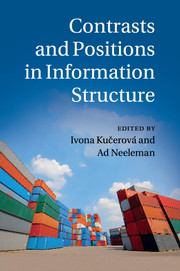1 - Introduction
Published online by Cambridge University Press: 05 August 2012
Summary
The problem
The chapters in this volume deal with the question of how information-structural notions are expressed in grammar. As is the case for other studies of linguistic interfaces, the complication in answering this question lies in the number of variables to be taken into account. In the case at hand, it is necessary to decide: (i) what interpretive notions should be considered information-structural primitives; (ii) what means the grammar has at its disposal to express information structure; and (iii) what the possible range is of the mapping rules that connect the two systems. These questions are interrelated, in that the answer to any one of them will affect the answers that can be given to the others. The challenge is therefore considerable. However, there is also a considerable pay-off, as a better understanding of linguistic interfaces is fundamental to our attempt to develop an adequate theory of the human language faculty. And there is some reason for optimism, as over recent years our insight into the relationship between grammar and information structure has increased substantially.
One of the surprising findings in the literature on information structure is that there is a relatively restricted set of interpretive notions affecting the grammar of natural languages. These include pairings like given–new, focus–background and topic–comment, and possibly additional notions like contrast and exhaustivity. It is clear that these notions may require refinements and subdivisions, but there does not seem to be a substantial case in the literature for extending the set. To give an example, categories may refer to individuals whose existence is implied by, but who are not explicitly mentioned in, previous discourse. Speakers treat such categories either as new or accommodate them as given, and their grammatical behaviour corresponds to which of these options is chosen. However, we are not aware of languages that place them in a separate class that is characterized as neither new nor given and that has its own syntactic distribution. So, the given–new dimension is limited to the familiar binary distinction, and not ternary. In the same vein, it doesn't seem to us that the limited number of familiar information-structural notions is a matter of sloppy labelling.
- Type
- Chapter
- Information
- Contrasts and Positions in Information Structure , pp. 1 - 24Publisher: Cambridge University PressPrint publication year: 2012
- 2
- Cited by



